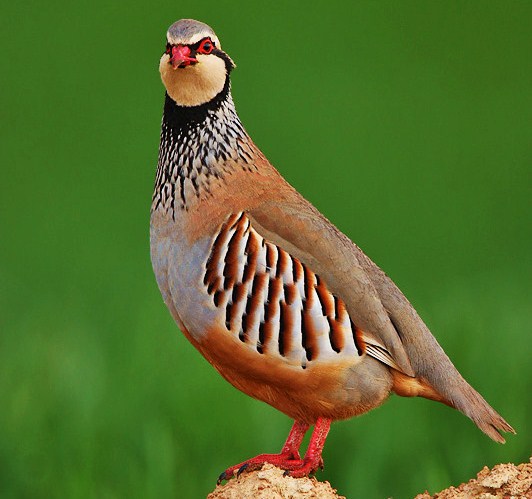Alectoris rufa
 |
| Photo by José Ardaiz (Fotonatura) |
Common name:
Taxonomy:
Order Galliformes
Family Phasianidae
Range:
The red-legged partridge is native of south-western Europe, being found from portugal and Spain, through France and into Italy and southern Germany. This species is a popular game birds and it has been introduced to several countries, namely Algeria, Greece, Ireland, U.K. and New Zealand.
Size:
These birds are 32-36 cm long and have a wingspan of 47-50 cm. Males tend to be larger than females. The females weigh 400-500 g while the males weigh 500-550 g.
Habitat:
Red-legged partridges are generally found in agricultural areas, grasslands and natural pastures, open woodlands, Mediterranean scrublands and in rocky areas. They are present from sea level up to an altitude of 2.000 m.
Diet:
These birds eat a wide range of plants, including the seeds of both natural and agricultural cereals, leaves, roots and shoots of green grasses and wild fruits and berries. They sometimes also eat insects.
Breeding:
Red-legged partridges breed in April-July. The male builds the nest, a shallow scrape on ground, screened by rocks or vegetation and thinly lined with vegetation. There the female lays 10-16 creamy-yellow or buff eggs with with reddish-brown or grey spots and blotches. The eggs are incubated for 23-25 days and the female is responsible incubating the first clutch while the male incubates the second clutches if a second clutch is layed. The chicks are able to feed by themselves a few days after hatching and are able to make short flight at 10 days of age, but will remain with the parent until 50-60 days after hatching. Each pair raises 1-2 clutches per year.
Conservation:
IUCN status – LC (Least concern)
This species has a very large breeding range and a global population estimated at 6-13,5 million individuals. The population is declining owing to over-hunting, loss of habitat caused by urbanisation and agricultural intensification and increased competition and hybridisation with introduced rock partridges A. graeca and chukar partridges A. chukar, but overall it is not considered threatened at present.







